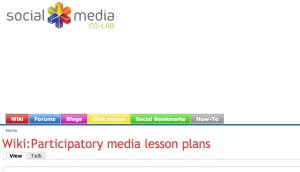Meeting Howard Rheingold
How could a day start any better than listening to a Howard Rheingold talk? I ask ya. And here’s how he began…
Learning should be…
– learner-centered
– social and peer-to-peer
– networked
 Rheingold explained that, at the beginning of his teaching career, he was influenced by Neil Postman’s book Teaching as a Subversive Activity – “the questions that students ask are more important than the answers they give.” This doesn’t mean you abandon the texts, but you start with questions, and you make it collaborative.
Rheingold explained that, at the beginning of his teaching career, he was influenced by Neil Postman’s book Teaching as a Subversive Activity – “the questions that students ask are more important than the answers they give.” This doesn’t mean you abandon the texts, but you start with questions, and you make it collaborative.
Howard wrote an article in a 1987 issue of The Well entitled “Virtual Communities” – and thus the term was coined. The article grew into a book, by the same name. In 1995, he was asked by the NEC corporation to help them envision a university of the future. He showed us images of mock-ups he created, with the help of a graphic artist, that looked surprisingly like the profiles that people create in Facebook and MySpace.
In his teaching, Howard emphasizes social learning. As he puts it, students are going to live and work socially and yet the methods and the literature of social learning are not being used.
Here is Howard’s social media classroom platform (built with funding from HASTAC) which he uses to amplify the social environment for his students. The hub includes wikis, blogs, and forums (see the colored tabs at the top in the screenshot above). He’s added lesson plans for educators to help them integrate the technology into the learning – those are available in the wiki portion. With this platform he and his students can index and search through different discussion threads (advantage over Facebook). His goal is to develop the group voice of his class (through forums), along with the individual voice of the student (with blogs).
He describes his approach to his courses as “co-teaching” – students do projects, present to peers, and collaboratively author. There’s no canon to his course, but he does want to give his students background/support research and a vocabulary with which to effectively discuss media together. To help with this, there is a “lexicon” wiki on his social media site where the students in the course work collaboratively to define the terms used in the course. In class time, Howard projects the history page and they work on the lexicon together.
Howard explains that he always has the students in his course sit in a circle…
“There are no back rows in a circle”
The co-teaching teams within the course also make mind maps on the topics they present to each other. This enables them to see the subject matter in a non-linear and networked way. His syllabus is posted on the wiki and offered up as a prezi and a concept map – he requires students to read the syllabus in its entirety, but they can look at it in a number of ways. By doing so, he signals that it’s important to be able to look at material through different lenses.
In addition to his face-to-face teaching, Rheingold is now experimenting with online learning. He’s recently formed RheingoldU (he charges $300 for a 5-week session). His first course: Introduction to Mind Amplifiers. He calls the students here “co-learners” – he defines the borders of the learning, but they decide from there how and where to go. Each student has a blog and they use the course wiki, along with live sessions and streamed video. He encourages the participants to do a group mind-map in the white board on the webinar platform (I’ve seen Nancy White do this as well to great effect). One of the interesting things about that exercise is that you don’t know who’s adding what – it’s a bit of magic, showing them how they can act as a collective intelligence. What Howard terms, “Peerogogy” (you heard it here, folks, a new, catchy Rheingold-term!)
Howard has created mini-courses – learning objects on a given topic that are served up online. Each of the mini-courses has a short video (10-15 minutes) of Howard talking, along with other resources, Delicious links (available with tabs). Here’s a sample: A mini-course on network and social network literacy. As Howard puts it, “we have the tools available to us to “roll our own” – for free!”
He says he’s been amazed at his students’ limited social literacy. They don’t understand the rhetoric of a wiki, how you can use a forum for group discussion, how to use a blog to reflect and clarify your thinking. He sees this as a critical education priority going forward.
Howard has been working with his students on something that he calls “Infotention” (yup! there’s another one!) – developing your attention skills, training your attention span, and learning how to use IT skills (RSS feeds, persistent news search, and dashboards) to support your attention. As Howard put it, it’s critical to use the information that’s flowing into you in a way that allows you to make faster and better decisions. Asking yourself, for example…Ignore or attend? Open a tab for later? What are the right spatial arrangements (highest priority on the left, most frequently updated is on the top). He tries to help his students match their attention to the tool set, to start small and cultivate habits. He also cautions that there are days we must recognize that we need to get something specific done and therefore must be mindful of how your attention is spent. Set a goal and then regularly, through the day, ask yourself, is what I am doing now bringing me closer to my goal for the day?
He described an interesting (very low tech) activity he does with his students using yellow, orange and red post-it notes. A gong goes off at irregular intervals and, at that point, students write down what they were thinking about on the appropriate colored post-it notes. Yellow if the thought was on task, orange if it tangential to the task at hand, and red if it was off task. The post-its get assembled in a common spot on the board (this could be done online as well) so that the entire class can track its collective “infotention”.
He talked about the importance of critical consumption (what Ernest Hemingway called “crap detection”). He used the classic Martin Luther King example – search on “Martin Luther King”, note the third entry down. Go to Easywhois to find out who owns the domain and you discover that the page is owned by a white supremacist organization. Other examples like this: Free Online Pregnancy Test – enter your name, sit still while we scan you. Genetics First. Pacific Northwest Tree Octopus. He’s got a million of them.
Howard’s wrap up: Our future depends upon participation, collaboration, and network awareness. He has a new book coming out called Net Smart (published by MIT Press) which he decided to write because, with all of the marvels of the online world, there is still a lot of crap out there. We can’t really regulate this (nor would we want to), but we can improve and increase the number of people who know what they are doing so that we can properly sort through it.
After he concluded his talk, as he packed up his bag, I made my way to the front to introduce myself. While I am a long-time Rheingold fan, I had a further purpose – he has accepted an invitation to join our New Media Faculty Seminar (which meets in Second Life) in two weeks. He was gracious and warm, shook my hand, and said he was looking forward to joining us in world. Class act.



Thanks for this nice post. I (my avatar) can’t wait to meet mr. Rheingold today in our intellectual park. Our topic today is very interesting. See you guys later. Looking forward
Oh, I have to try that post it note thingie! Fab! Thanks for sharing it.